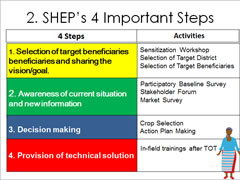The Four Steps are the core concept at the heart of the SHEP. They explain in detail how to implement the SHEP approach. The various activities that make up the Four Steps are designed to boost farmers' motivation to make improvements to their farming operations and promote agriculture as a business pursuit. The activities in the table below are examples from Kenya. Note that we encourage individual countries to customize these activities so that they are better suited to local contexts.
What are the Four Steps?
The SHEP approach can be roughly divided into four steps.
1. Select target farmers and share aims
We start by holding an activity orientation session for all actors, including farmers, in order to explain project concepts and the like. During this process, participants gain a better understanding of the activities they will be carrying out as well as their personal roles and responsibilities. We also share the vision of market-oriented agriculture.
2. Create opportunities for awareness
The purpose of this step is to create opportunities for farmer awareness. Activities included in this step are the participatory baseline survey, stakeholder forum, gender and family budgeting training for both men and women, and farmer-led market surveys. The market survey carried out by the farmers themselves is considered to be the most important activity in this step.

- During the participatory baseline survey, farmers get a clear grasp of their current situation by analyzing various kinds of data on farming operations, including yield. They carry out the survey themselves with the help of extension workers and others.
- During the stakeholder forum, farmers' associations and those involved in the horticulture industry exchange information for the purpose of building business linkages.
- The gender and family budgeting training is a session that both male and female farmers and extension workers participate in together. During this activity, husbands and wives are encouraged to work together as agricultural partners, sharing farm work and operations in order to boost productivity.
- During the market survey, make in-person visits to markets in order to conduct the survey. They collect information not only on prices, but on quality and volume demands, price trends, items that are selling out, and more.
3. Farmer-led decision-making
Based on the results of the market survey, the members of farmers' groups decide which crops to grow while discussing shipping periods and other issues.
4. Providing technical solutions
During this step, farmers learn the techniques they need to produce the crops that are in demand in their selected markets. Farmers decide for themselves which crops to plant based on their work in steps 1–3. They then team up with extension workers to figure out which techniques they'll need to cultivate those crops. Because technical solutions are provided in response to what farmers need, farmers are motivated to learn, which in turn results in high adoption rates.
Key points for the Four Steps
What's the difference between the SHEP approach and the countless farming projects that have already been implemented?
Key point #1 The participatory baseline survey
- Extension workers and farmers carry out the survey together
- Question items that are easy for extension workers to manage are used
- Farmers get specific, practical information on the status of farming operations and at the same time learn what it is they don't yet know
(Conventional projects hire outside experts to conduct baseline surveys. There are no opportunities for farmers' associations to participate in the survey analysis or for their feedback to be counted. Crop selection is also done either by outside experts or by the project itself.)
Key point #2 The stakeholder forum
- Participants are limited to farmers' associations and those involved in the horticulture industry. Participants prepare a profile in advance for everyone to see so that they can think about who they might want to establish business partnerships with.
- Only horticultural industry players who are able to do business with farmers' associations are selected to participate.
- The form is set up so that farmers' associations can go around to horticulture industry booths to discuss business.
(Conventional projects regularly hold forums for agricultural ministries and the like, but these events are no more than agricultural expositions. When anyone can freely come and go, it's more difficult to build relationships—since nobody knows exactly who the participants are. This leads to relatively few business contracts.)
Key point #3 Market survey
- Extension workers and farmers themselves go to nearby markets to conduct observations.
- The surveys are a chance to get firsthand information at markets as well as get to know market actors.
- The surveys give farmers a clear understanding of market needs and the information they need to select the best crops.
- Because the surveys are carried out during the initial stages of the project, they give farmers a real sense of the price and potential in horticultural crops. This opens their eyes to idea that crops can be grown for profit.
(Conventional projects have outside experts conduct detailed market surveys, with farmers making little or no contribution. Survey results are also analyzed by outside experts, the resulting marketing information typically distributed to extension workers and farmers' associations through the media. Farmers often cannot take advantage of this information either, as most never receive information specifically for their area, or don't have the means to make changes.)
Key point #4 Demand-driven technical training
- These training sessions teach farmers who have already made decisions based on the results of the market surveys exactly what they want to know.
- Extension workers learn about the things farmers want to know during Training of Trainers (ToT) sessions, and then pass that information on to the farmers.
(Conventional projects hold training sessions whose content is determined by outside experts, the project, or government agencies. For this reason, the farmers feel forced to attend, and the techniques rarely take hold.)




scroll